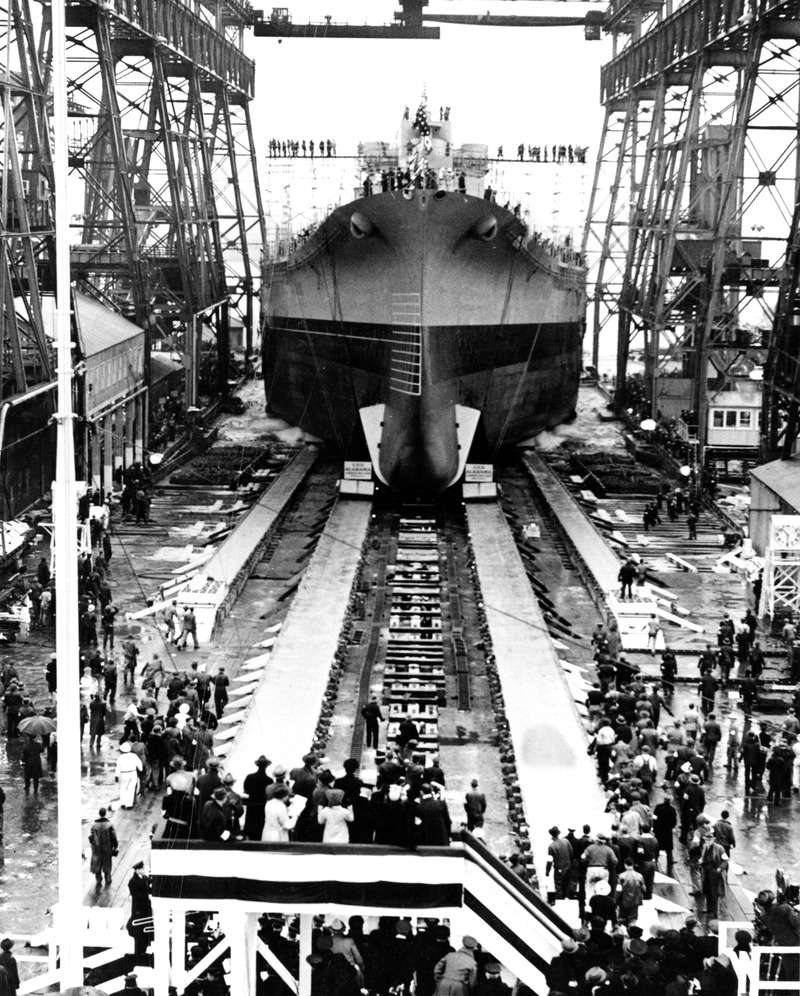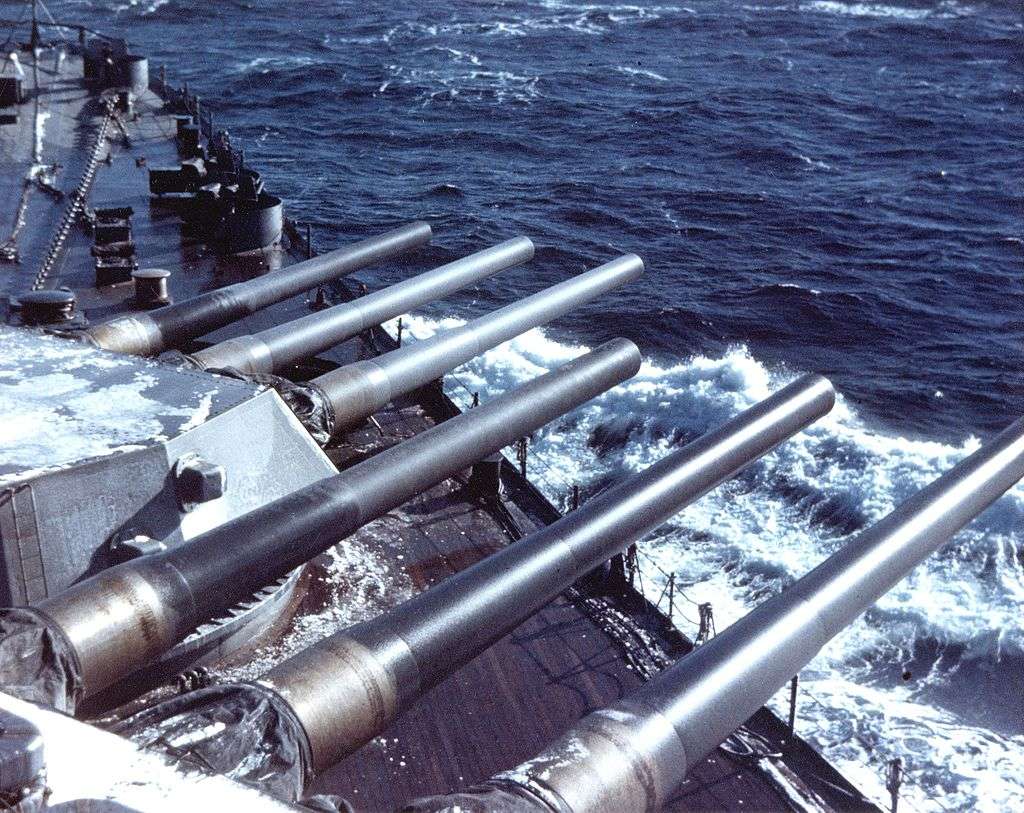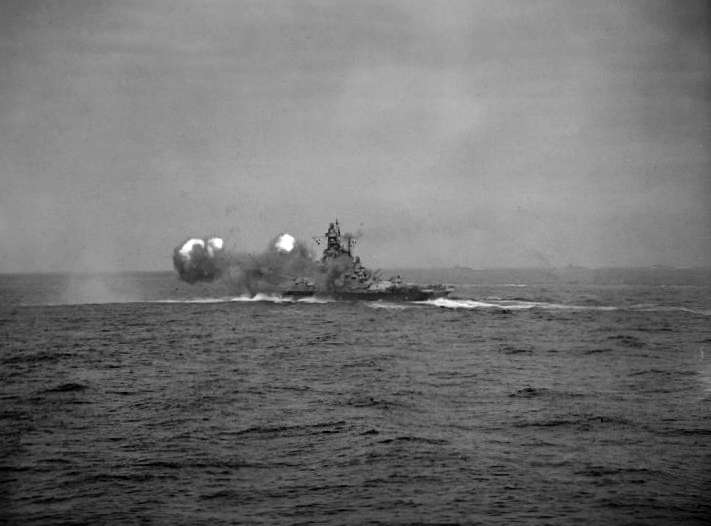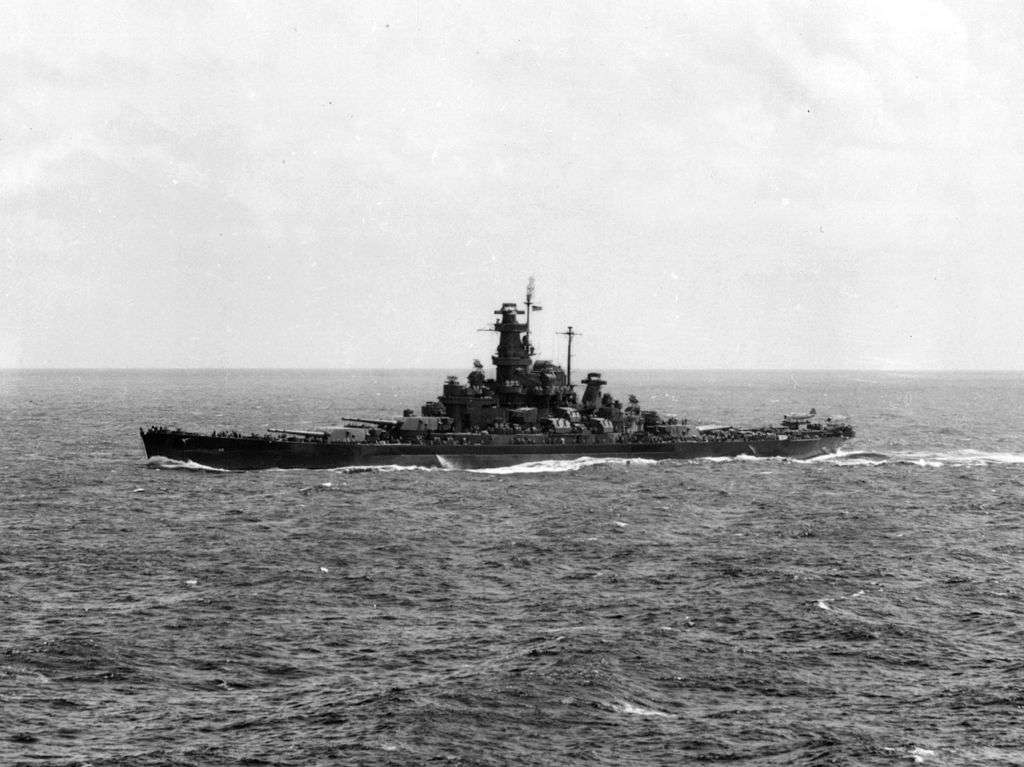The USS Alabama (BB-60) is a South Dakota-class battleship, launched in 1942, that served in the U.S. Navy during World War II.
Notably active in the Pacific Theater, the Alabama participated in numerous significant campaigns and earned nine battle stars for her service.
Today, she stands as a museum ship at Battleship Memorial Park in Mobile, Alabama, preserving a rich history and serving as a monument to those who served aboard her.
Design and Development
The Alabama’s story begins in the early 1930s, against the backdrop of the Washington and London Naval Treaties.
These treaties, designed to prevent a global naval arms race following World War I, placed significant restrictions on the size, armament, and total tonnage of warships each nation could possess.
The U.S., like other naval powers, was compelled to navigate these restrictions in its naval construction programs, leading to the development of a new class of battleships – the South Dakota-class – designed to optimize firepower, armor protection, and speed within a tightly constrained displacement limit.
The design and construction of the USS Alabama are emblematic of the careful balancing act required by the international treaty constraints and the military requirements of the time.
Her construction began in February 1940 at the Norfolk Navy Yard, one of the United States’ largest and most technologically advanced shipyards.
Adherence to the Washington and London Naval Treaties’ stipulations was paramount in the ship’s design.
These dictated that new battleships should not exceed a standard displacement of 35,000 tons and that their main armament should not exceed 16-inch caliber guns.
Thus, the USS Alabama and her South Dakota-class sisters were designed to maximize their capabilities within these constraints.
 Launching of the USS Alabama at Norfolk Navy Yard, Portsmouth, Virginia, 16 February 1942.
Launching of the USS Alabama at Norfolk Navy Yard, Portsmouth, Virginia, 16 February 1942.
In response to these limitations, the designers of the Alabama emphasized compactness and efficiency.
The ship’s hull measured approximately 680 feet in length and 108 feet at the broadest point (beam).
This made the South Dakota-class ships significantly smaller than their successors, the Iowa-class, which were over 860 feet in length.
Despite the smaller size, the Alabama was able to pack a potent punch, housing a massive primary and secondary armament, robust armor, and a host of technological advancements, all skillfully fit into the smaller hull.
Aesthetically, the Alabama adopted a functional, military style with a streamlined superstructure and a clutter-free deck.
The ship also boasted a “clipper bow,” a design innovation characterized by an extended overhang at the front.
This feature, though visually distinctive, was primarily functional, designed to improve the ship’s handling in high seas and increase seaworthiness.
The USS Alabama was commissioned in August 1942. It was the sixth ship to bear the Alabama namesake and the fourth member of the South Dakota-class.
Armament and Armor
The armament and armor of the USS Alabama were crucial factors determining her offensive and defensive capabilities, designed to ensure optimal effectiveness in the emerging naval battlefields of the 1940s.
The primary armament of the Alabama comprised nine 16-inch/45 caliber Mark 6 guns, configured in three triple turrets, two positioned forward and one aft.
These guns were the heart of the ship’s firepower, capable of hurling a 2,700-pound armor-piercing shell over a distance exceeding 20 miles.
The turrets housing these guns allowed for a significant elevation range, enabling the Alabama to engage both naval and terrestrial targets effectively.
Complementing the main guns was the Alabama’s secondary armament: twenty 5-inch/38 caliber dual-purpose guns housed in ten twin turrets. Designed to engage both surface targets and aircraft.
In addition to these heavy guns, the Alabama was also equipped with an array of lighter anti-aircraft weapons.
These included a variety of 40mm Bofors and 20mm Oerlikon anti-aircraft guns, which were added and upgraded over the course of the war.
 USS Alabams forward guns.
USS Alabams forward guns.
Equally critical to the Alabama’s design was her armor scheme. The ship followed an “all or nothing” armor philosophy, which dictated that the most critical areas of the ship, such as the magazines and propulsion spaces, were heavily armored, while less critical sections were less protected.
This strategy optimized the use of available weight for protection, concentrating it where it would be most effective.
The Alabama’s main belt armor was up to 12.2 inches thick, providing significant protection to the ship’s vital areas along the waterline.
The turret armor, protecting the main guns, was up to 18 inches thick, capable of withstanding heavy-caliber shells.
Additionally, the conning tower, where the ship was commanded during battles, was encased in 16 inches of armor.
The Alabama also featured a double bottom and extensive watertight compartmentalization to improve survivability in case of torpedo attacks or underwater explosions.
Propulsion and Technological Features
The Alabama was equipped with four General Electric geared steam turbines, powered by eight oil-fired boilers.
This propulsion system was capable of generating 130,000 shaft horsepower, enabling the ship to reach speeds up to 27 knots, approximately 31 miles per hour.
This speed was impressive for a ship of her size and made the Alabama a versatile asset, able to keep pace with aircraft carriers and respond swiftly to tactical developments.
Furthermore, the Alabama had a fuel capacity of about 6,300 tons of fuel oil, granting her a maximum range of approximately 15,000 nautical miles at a cruising speed of 15 knots.
 USS Alabama pictured from the air, giving us a great view of its beautiful shape.
USS Alabama pictured from the air, giving us a great view of its beautiful shape.
In addition to her robust propulsion system, the Alabama was equipped with a range of cutting-edge technological features.
One such feature was the ship’s radar systems, including the SK air-search radar and the SG surface-search radar.
These radar systems significantly improved the Alabama’s combat awareness, enhancing her ability to detect and engage enemy units, even under conditions of poor visibility or inclement weather.
The ship also housed sophisticated fire control systems, responsible for directing the fire of the Alabama’s formidable battery of guns.
These systems used a complex array of inputs, including radar data, visual sightings, and complex computations, to calculate firing solutions.
Finally, the Alabama featured an array of auxiliary systems that supported her operations.
These included communications systems, damage control stations, and life support systems that ensured the ship could operate under challenging conditions and recover effectively from damage.
Operational History
In August 1943, the USS Alabama sailed across the Atlantic to Scapa Flow, becoming part of the British Home Fleet.
This initial deployment had her operate in northern waters, undertaking patrol and convoy escort missions.
In late 1943, the Alabama was reassigned to the Pacific Theater.
Her first major action was during the Gilbert Islands operation in November 1943, where she joined Task Force 58.
Her primary role was providing bombardment support for the amphibious invasions, using her massive 16-inch guns to engage and neutralize enemy fortifications, as well as to protect the landing forces from counterattacks.
The next major campaign the Alabama participated in was the Marshalls campaign, which commenced in January 1944.
 USS Alabama firing her guns on exercise in 1943.
USS Alabama firing her guns on exercise in 1943.
The Alabama played a crucial role in the bombardment of Kwajalein and Eniwetok atolls, two key objectives during this campaign.
In June 1944, the Alabama took part in the Mariana and Palau Islands campaign.
This was a critical offensive aimed at capturing the Mariana Islands and neutralizing the Japanese naval and air presence there.
The Alabama’s contributions were twofold. Firstly, she provided heavy bombardment of enemy positions on Saipan and Tinian, paving the way for the landing of U.S. troops.
Secondly, during the Battle of the Philippine Sea, she served as part of the screen for the aircraft carriers of Task Force 58, protecting them from enemy air attacks.
This battle saw the destruction of a substantial portion of Japan’s carrier-based aircraft, earning it the nickname “The Great Marianas Turkey Shoot.”
The Alabama continued her active service through the latter stages of the war.
In March 1945, she supported the invasion of Okinawa, the last major amphibious assault of the war.
Once again, her 16-inch guns pounded enemy positions, while her anti-aircraft batteries fended off the increasingly desperate kamikaze attacks by Japanese aircraft.
After Japan’s surrender in August 1945, the USS Alabama undertook ‘Magic Carpet’ duty, transporting American servicemen back home from the Pacific.
She was finally decommissioned in January 1947, having earned nine battle stars for her service during the war.
Legacy and Current Status
After the end of World War II, the USS Alabama served briefly in the Atlantic fleet before she was decommissioned in 1947 and placed in the reserve fleet, marking the end of her active military service.
Yet, even as the era of the battleship receded, the Alabama’s story was far from over.
The battleship remained in the reserve fleet for over a decade before the decision was made to scrap her.
This prompted a campaign by the citizens of Alabama to save the ship and turn her into a museum.
 USS Alabama in the Pacific, 1944.
USS Alabama in the Pacific, 1944.
Since 1965, the USS Alabama has resided at the Battleship Memorial Park in Mobile, Alabama, where she serves as a museum ship.
Every year, hundreds of thousands of visitors walk her decks, exploring the ship’s compartments, viewing her formidable guns, and learning about her service during World War II.
The USS Alabama’s legacy is a multifaceted one. She stands as a testament to the ingenuity and skill of the shipbuilders and engineers who designed and constructed her.
She represents the bravery and professionalism of the sailors who served aboard her during one of the most tumultuous periods in world history.
And she serves as a symbol of the determination and generosity of the people of Alabama, who banded together to ensure that she would be preserved for future generations.
Today, the USS Alabama continues to educate and inspire, serving as a tangible link to our past and a beacon of historical remembrance.
Her guns may be silent, and her engines still, but her story continues to resonate, a stirring reminder of the power, bravery, and ingenuity that marked the World War II era.
The USS Alabama is not merely a ship, but a crucial part of our shared history, a symbol of human endeavor in the face of challenge, and a lasting tribute to those who served in the crucible of war.
News
A Creative Journey: Lady Gaga’s Artistic Growth and Fearless Embrace of Individuality
The weirdness and craziness of star Lady Gaga’s outfits have been increasing every day. Even if she were dressed in rags and beggar clothes, no one would be surprised. Lady Gaga created her own unique, shocking fashion line that no…
Gaga’s Street Style: No Bras, Semi-Sheer Top, and Daring Daisy Dukes in NYC
Lady Gaga recently unveiled the much-anticipated track list for her latest album, Joanne, and she is certainly not shying away from the limelight. The singer was spotted in New York on Saturday confidently flaunting her unique fashion sense. Her daring…
VIDEO : Unexpected Flashback: Old Footage Resurfaces Showing Lady Gaga’s Unusual On-Stage Act with a Girl Vomiting on Her Chest
It’s come back up. A clip of a woman making herself vomit on Lady Gaga during her SXSW performance in 2014 has resurfaced online — and the bile hasn’t aged well. Gaga, 36, incorporated performance artist Millie Brown into her choreography…
My First Piano Teacher Was a Stripper’: Lady Gaga Reveals Dad Hired a Stripper as Her Music Teacher, Linking it to Her Signature Long Nails
Lady Gaga is one of the popular artists who’s known for image reinventions and musical versatility. She rose to fame with her debut studio album, The Fame in 2007 with its chart-topping singles Just Dance and Poker Face. She is not only…
20 Bizarre Photos Prove That Lady Gaga Is The Most Unhinged Fashion Icon Ever
One of the most iconic and multi-talented artists of our time, Lady Gaga, with worldwide hits such as Bad Romance, Judas, and Born This Way, is also known as a composer, an actress, and above all, a fashionista. Known as…
Lady Gaga Goes Makeup-Free for Oscars Performance, Letting People See the Real Her
Oscars executive producer reveals Lady Gaga decided to go makeup-free during her performance to show people the ‘real’ her. Featured Image Credit: ABC Yesterday (March 13), the musician stunned viewers with a performance of the Oscar-nominated song ‘Hold My Hand’…
End of content
No more pages to load











